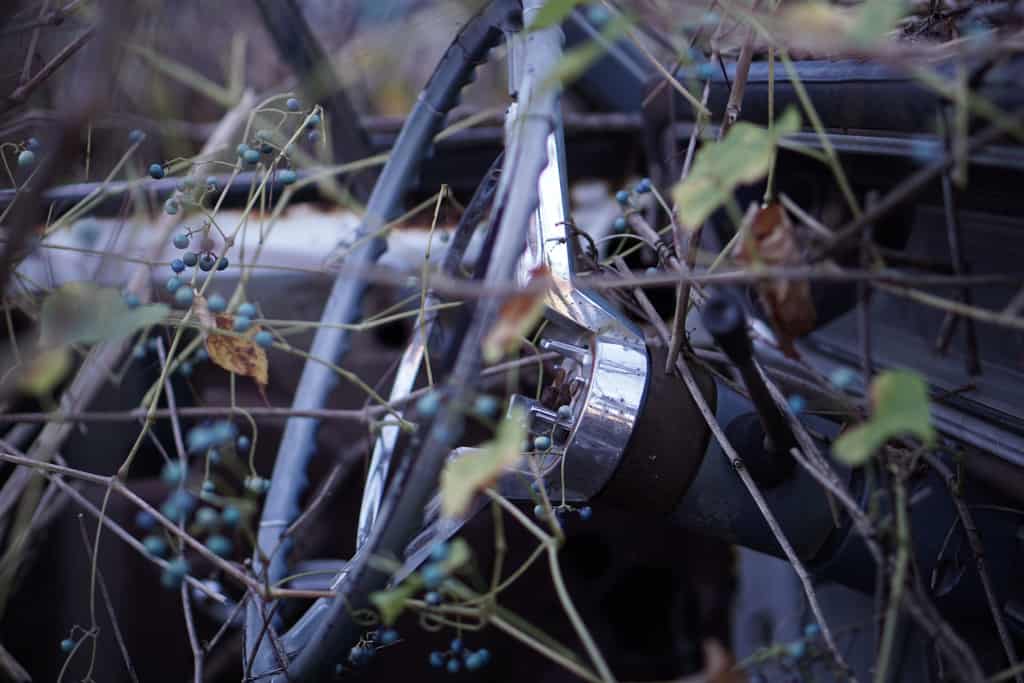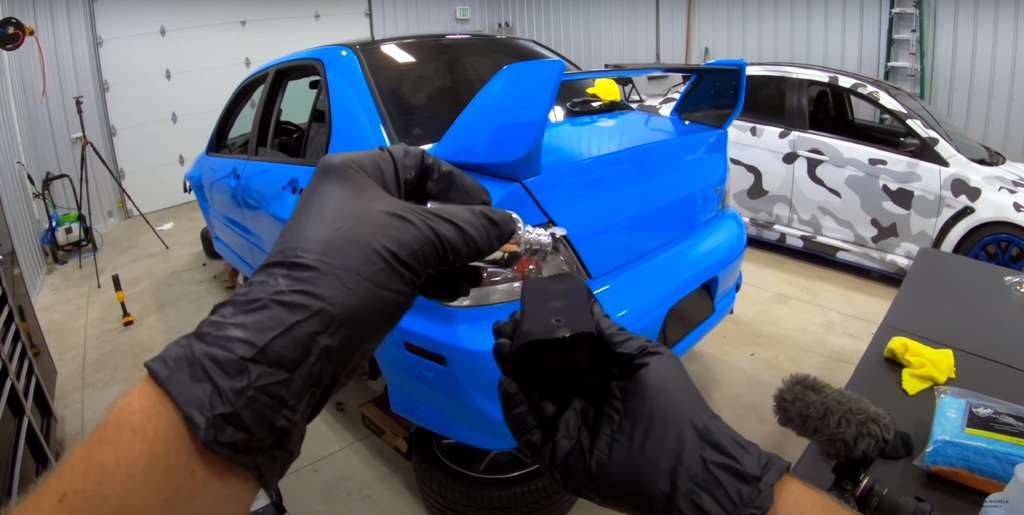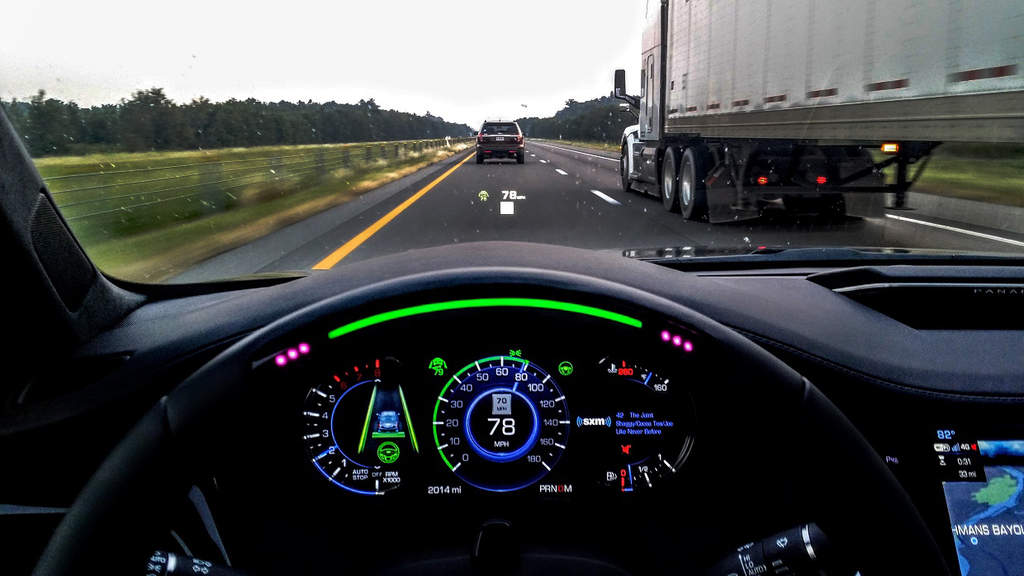Have you ever awoken, only to discover that your car had been covered in berry stains overnight? As you inspect the juicy, brightly hued pulp sprawled across your vehicle’s paint, you recall the scene from Mrs. Doubtfire, where Robin Williams tags Pierce Brosnan in the back of the melon with a large piece of citrus and then blames it on a “run-by fruiting.” Since roving bands of fruit-flinging miscreants remain extremely rare (thank goodness), chances are that the perpetrator is a stain-inducing fruit tree, and these troublemakers are far more commonplace than you think.
For as much as humans enjoy eating berries, the issues that arise when these sweet morsels are left to dry atop a car’s clear coat are plentiful. However, unlike the never ending bird poop battle, berry stains can be avoided by simply selecting a safe parking place, and when present, berry stains can be easily removed if caught in a timely fashion.
What Sort of Berry Stains Are on Your Car?

So now that we’ve identified that it isn’t just brightly hued bird droppings that are kicking your clear coat’s ass, it’s time to identify the root cause of this deeply pigmented problem. Prevention is the best medicine here, so in order to avoid being bombarded by berries, one must first determine which trees are most inclined to drop stain-saturated berry bombs. While there are quite a few trees that produce purple pigmented produce, the following trees tend to be the most commonplace culprits. Ironically, many of these trees are popular options for lining roadsides and driveways, giving the trees an unfair advantage in the berry battle.
Serviceberry/Juneberry Trees– Serviceberry Trees are a rotund, highly attractive specimen that is revered for its fanciful fall foliage, appealing shape, and ability to produce super sweet berries with a flavor akin to blueberries. Unfortunately, much like blueberries, these Service Berries are quick to spoil and are prone to staining anything they come into contact with. Keep a keen eye open for these little round red juice bombs come June, as that is when they tend to ripen, thus earning the tree a befitting nickname: “The Juneberry Tree.”
Mulberry Trees– Looking much like an elongated blackberry, the fruit from a Mulberry Tree is large and loaded with stains. Although the white mulberry poses less of a threat to a car’s clear coat, the red mulberry offers every imaginable dark red and purple pigment. Oh, and when we said that the white mulberry is less of a threat, we didn’t mean that this tree’s fruit won’t wreck your ride. Although the majority of a white mulberry’s crop tends to be white or light pink, berries on these trees have been known to darken to red and purple hues as well, and come loaded with sticky seeds.
Dogwood Trees– Although the common Dogwood Tree is adored for its flower-like leaves, certain species are known for producing a stain-rich berry. There’s even a version called the “Cornelian Cherry Dogwood,” which produces a super sour, somewhat acidic fruit that resembles a cherry. Birds love to eat these brightly colored berries too, which means that if they poo while flying over your car… well, you get the picture.
Ginkgo Trees– In the autumn you have another threat to worry about, which in many parts of the world, is considered to be one of the most detrimental fruits to ever hit a parked car. Yes, we’re talking about the dreaded Ginkgo Tree, and its foul-smelling, plum-shaped fruit.
Ginkgo trees are dioecious, which means that they can either be male or female, and are pretty much indistinguishable from one another until they reach sexual maturity. Around this time the female trees will start producing a brown-to-orangish fruit in the fall that resembles a plum. It is this fleshy fruit that car owners loathe, as it splatters easily, and quickly eats into car films and clear coats alike. Compounding the matter is the fact that once crushed, the stench that the fruit releases is akin to a combination of spoiled butter, vomit, and fresh dog feces. These stain-filled nuisances are everywhere too, with Ginkgo numbers in New York City alone topping well over 16,580 trees within city limits!
The Glossy Privet– This extremely resilient tree is labeled invasive in most areas of North America due to its ability to reproduce quickly, and the clusters of messy berries it bares in the autumn. These small, blackish berries are a favorite food for many types of birds, so if there’s an opaque poo splattered across your car’s windshield, chances are this berry is what they were nibbling on a few hours ago.
The California Pepper Tree- Although the berries of this tree do not smell like pepper (it’s the leaves that emit the aroma), these trees do make a royal mess when their berries “pepper” your car. The California Pepper Tree is another invasive berry tree that reaches peak ripeness in autumn and winter, as millions of light pink berries prepare to pelt unsuspecting vehicles below.
What season poses the greatest risk of berries damaging a car’s paint?
Unlike pollen season, which typically occurs in spring, there is no set schedule for berries in regard to ripeness. While one might assume that autumn and winter are the safest seasons, the evidence we have just provided proves otherwise, as different trees produce berries at various times of the year. Granted, warmer weather tends to have the greatest risk of stains, as wild cherries, lychee, mangosteen, pomegranate, mango, mulberry, and all manner of plum ricochet off your car’s roof.
Quick Tip: In order to avoid berry-laden trees, and the clear coat seasonal car care corrupting conundrum that comes with them, one must seek out safe forms of shade. If you can’t handle the scorching sensation of hot leather seats on your precious posterior, you’re going to have to keep your eyes peeled for a tree to park under that is devoid of berries, or better yet, seek the shelter of a parking garage or bridge.
Types of Damage Berry Stains Can Inflict Upon a Car

So try as you might, the dreaded berry of doom has anointed your vehicle with its blood-red juices, and now you must remove said stain. There’s just one problem. You haven’t driven your car for over a week, and the berry has transformed from sticky stain to a petrified pulp, and panic has set in. Can a berry stain cause permanent damage to a car’s paintwork???
Being that the juice of most berries is acidic in nature, the risk of the pulp penetrating the clear coat and etching into a car’s paintwork over time is quite real. Berry (or brightly hued bird turd stains) need to be removed ASAP, because the longer these acid-rich deposits sit, the worse the damage will become with time.
Outside of damaging paint, berries have also been known to stain plastic trim and are notorious for permanently discoloring soft cloth tops on convertible cars. Berries will also eat into modern headlamps, thus making the task of resurfacing and cleaning headlights all the more labor intensive. Naturally, cars with lighter colors tend to be the most susceptible to the lasting effects of berry stains, turning something as simple as stain removal into a full-blown chore.
Tools and Supplies Needed to Remove Berry Stains From a Car

So what do you do if you wake up one morning to discover that the berry-laden Mulberry you parked beneath the night before had bestowed its sticky-sweet gifts upon your automobile? Will a quick spray with the garden hose suffice, or will you have to hit the local auto store for supplies? What if it’s a holiday and the auto store is closed? Are there any common household products you can use to remove the stains caused by trees with berries, or will they only further damage your car’s paint?
In an interview with Today, founder and CEO of Mulberry’s Garment Care (ironic name, right?), Dan Miller, offered a handful of suggestions for removing berry stains from surfaces.
According to Miller, if you have to remove berry stains with household items, you should start by hitting the stain with a splash of lemon juice or vinegar and let it sit for no more than five minutes before rinsing the area in question with water. Let the lemon juice or vinegar sit for too long and you run the risk of allowing the acid contained within these liquids to eat into the car’s clear coat.
Baking soda on a wet microfiber towel is another quick fix you can try in a pinch. Just be forewarned, the abrasion level of baking soda can be quite high, so proceed with caution, and don’t press down on that microfiber cloth too hard or you’ll damage the car’s clear coat.
A blend of Isopropyl Alcohol, or rubbing alcohol, and distilled water has the ability to cut through crud and lift stubborn residue when most other products fail. So if the big stuff blasts away without issue, but there’s still a stain underneath, give the area in need of cleaning a misty spritz of this magical elixir and watch that stubborn stain disappear. Just remember that you should always use the 91% stuff if possible, and never exceed a 25% alcohol to water ratio or you might damage the car’s paintwork.
If a quick blast with this acidic solution followed by a spray-down with the garden hose doesn’t do squat, it might be time to break out something a bit more man-made in order to remove those berry-based paint stains. You need something strong yet paint safe, and fortunately for you, there are quite a few options to choose from in the realm of automotive detailing products. As with all untested cleaners, it is best to start on the mild side, with something like a clay bar, or a fresh microfiber cloth and a waterless, “spray-and-wipe” detailing product. Just remember that the longer the berry stain sits on the vehicle, the harder it will be to remove, so it may take more than one pass before the stain begins to disappear.
Quick Tip: Clear coat approved scrubbing brushes and perforated sponges are also quite useful, just as long as they are not pressed down on too hard. The use of a pressure washer in its lowest setting is also a good method for berry removal, just be sure that you don’t get the tip of the nozzle too close to the surface, and try to avoid blasting one area for too long.
“Berry stains are plant-based and can be broken down (aka pre-treated) with acids such as lemon juice and vinegar.”
–Dan Miller, Founder and CEO of Mulberry’s Garment Care
How to Remove Berry Stains From Your Car Without Damaging the Paint

If the natural fix doesn’t cut the crud caked onto your car, detailing sprays prove “fruitless,” and the blast method doesn’t have an impact, it might be time to opt for a far more “abrasive” approach to removing those stubborn berry stains.
For a more aggressive plan of attack, use something like Meguiar’s Ultimate Compound. This stuff is 100% clear coat safe, and packs one hell of a gritty bite, turning everything from soot corroded exhaust tips to hazed-over headlights into blemish-free automotive components. Just remember that polishing compounds are like liquid sandpaper, so don’t hit that surface too hard or scrub one spot for too long, or you’ll cut right through the car’s clear coat and dull the paint underneath.
As a general rule of thumb, the use of things like fabric detergent, liquid dish soap, and chlorine bleach should all be avoided, as they can cause significant harm to car’s clear coat, and if left for too long, the paint underneath this protective layer. And while some people swear that hydrogen peroxide is safe to use, there are accounts of it damaging exterior surfaces, so use this solution at your own risk.
Quick Tip: While regularly washing your car is the best plan of attack when it comes to confronting things like berry stains and dried pulp, throwing a layer or two of ceramic coating at the vehicle will pretty much eliminate this issue. Being that products like AvalonKing’s Armor Shield IX pack water-displacing, ultra hydrophobic properties, and form an impenetrable bond once cured, the risk of berries wrecking your paint become non-existent once a ceramic coating fully cures.












